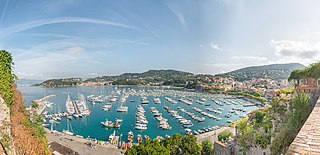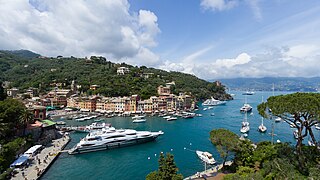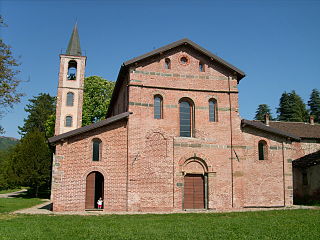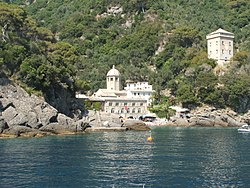
The Italian Riviera or Ligurian Riviera is the narrow coastal strip in Italy which lies between the Ligurian Sea and the mountain chain formed by the Maritime Alps and the Apennines. Longitudinally it extends from the border with France and the French Riviera near Ventimiglia eastwards to Capo Corvo which marks the eastern end of the Gulf of La Spezia and is close to the regional border between Liguria and Tuscany. The Italian Riviera thus includes nearly all of the coastline of Liguria. Historically the "Riviera" extended further to the west, through what is now French territory as far as Marseille.

The Doge of Genoa was the head of state of the Republic of Genoa, a city-state and soon afterwards a maritime republic, from 1339 until the state's extinction in 1797. Originally elected for life, after 1528 the Doges were elected for terms of two years. The Republic was ruled by a small group of merchant families, from whom the doges were selected.

The Republic of Genoa was a medieval and early modern maritime republic from the years 1099 to 1797 in Liguria on the northwestern Italian coast. During the Late Middle Ages, it was a major commercial power in both the Mediterranean and Black Sea. Between the 16th and 17th centuries, it was one of the major financial centres in Europe.

Portofino is a comune located in the Metropolitan City of Genoa on the Italian Riviera. The town is clustered around its small harbour, and is known for the colourfully painted buildings that line the shore. Since the late 19th century, Portofino has attracted tourism of the European aristocracy and it is now a resort for the world's jet set.

The House of Doria originally de Auria, meaning "the sons of Auria", and then de Oria or d'Oria, is an old and extremely wealthy Genoese family who played a major role in the history of the Republic of Genoa and in Italy, from the 12th century to the 16th century. Numerous members of the dynasty ruled the republic first as Capitano del popolo and later as Doge.

The Fondo Ambiente Italiano (FAI) is the National Trust of Italy.

Sampierdarena is a major port and industrial area of Genoa, in northwest Italy. With San Teodoro it forms the West Central municipio.

A doge was an elected lord and head of state in several Italian city-states, notably Venice and Genoa, during the medieval and Renaissance periods. Such states are referred to as "crowned republics".

Diano Castello is a comune (municipality) in the Province of Imperia in the Italian region Liguria, located about 90 kilometres (56 mi) southwest of Genoa and about 5 kilometres (3 mi) northeast of Imperia. As of 31 December 2004, it had a population of 2,061 and an area of 6.0 square kilometres (2.3 sq mi).

Santa Margherita Ligure is a comune (municipality) in the Metropolitan City of Genoa in the Italian region Liguria, located about 35 kilometres (22 mi) southeast of Genoa, in the area traditionally known as Tigullio. It has a port, used for both tourism and fishing activities. Part of comune territory is included in the Regional Natural Park of Portofino. Santa Margherita Ligure borders the following municipalities: Camogli, Portofino, Rapallo.

Genoa, Italy, has historically been one of the most important ports on the Mediterranean.

Boccadasse is an old mariners' village of the Italian city of Genoa. It lies within the borders of the neighbourhood of Albaro. In today's administrative subdivision it is located in the Municipio VIII - Medio Levante area which includes the neighbourhoods of Albaro, Foce, San Martino. Boccadasse is bordered on the west side by Via Felice Cavallotti, by Via Caprera on the northern side and by Via Capo di Santa Chiara on the eastern side. Naturally, it is delimited by the sea to the south.

The Delle Piane family is an old Genoese noble family first recorded in Polcevera in 1121. Over the past ten centuries it has produced many distinguished government officials, clerics, diplomats, soldiers and patrons.

Tiglieto Abbey is a monastery in Tiglieto, Liguria, northern Italy. It was the first Cistercian abbey to be founded in Italy, and also the first outside France.

Giovanni Doria, called Giannettino, the son of Giovanni Andrea Doria, 6th Prince of Melfi, and Princess Zenobia Doria del Carretto, 5th Princess of Melfi.

Genoa is a city in and the capital of the Italian region of Liguria, and the sixth-largest city in Italy. In 2023, 558,745 people lived within the city's administrative limits. While its metropolitan city has 813,626 inhabitants, more than 1.5 million people live in the wider metropolitan area stretching along the Italian Riviera.
San Fruttuoso may refer to:

Via Balbi is a street in the historical centre of Genoa, in Northwestern Italy, named after the aristocratic Genoese Balbi family. It is one of the Strade Nuove built by the Genoese aristocracy during the Renaissance. Since July 2006 it is inscribed in the list of UNESCO World Heritage Site Genoa: the Strade Nuove and the system of the Palazzi dei Rolli.

The Villa del Principe, Palazzo del Principe, or Palace of Andrea Doria in Fassolo is one of the main historical suburban villas of Genoa, Italy. It was built in the 16th century in an area that it is now located in the city center, but at the time of the construction of the villa was just outside of the city walls towards Capo di Faro and the Lanterna.

Giovanni Ponzello was an Italian mannerist architect active in the Republic of Genoa, where he supervised the construction of several distinguished palaces and churches during the Renaissance period.























